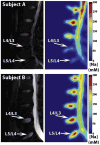Novel diagnostic and prognostic methods for disc degeneration and low back pain
- PMID: 26303178
- PMCID: PMC5473425
- DOI: 10.1016/j.spinee.2014.09.010
Novel diagnostic and prognostic methods for disc degeneration and low back pain
Figures





Comment in
-
Bringing truths from evidence: novel ways to detect pain derivation of low back.Spine J. 2016 May;16(5):676. doi: 10.1016/j.spinee.2015.10.059. Spine J. 2016. PMID: 27261846 No abstract available.
Similar articles
-
Patterns of lumbar disc degeneration are different in degenerative disc disease and disc prolapse magnetic resonance imaging analysis of 224 patients.Spine J. 2014 Feb 1;14(2):300-7. doi: 10.1016/j.spinee.2013.10.042. Epub 2013 Nov 12. Spine J. 2014. PMID: 24231779
-
A population-based study of juvenile disc degeneration and its association with overweight and obesity, low back pain, and diminished functional status.J Bone Joint Surg Am. 2011 Apr 6;93(7):662-70. doi: 10.2106/JBJS.I.01568. J Bone Joint Surg Am. 2011. PMID: 21471420
-
Disc degeneration and chronic low back pain: an association which becomes nonsignificant when endplate changes and disc contour are taken into account.Neuroradiology. 2014 Jan;56(1):25-33. doi: 10.1007/s00234-013-1294-y. Epub 2013 Nov 5. Neuroradiology. 2014. PMID: 24190653
-
Imaging the back pain patient.Phys Med Rehabil Clin N Am. 2010 Nov;21(4):725-66. doi: 10.1016/j.pmr.2010.07.004. Phys Med Rehabil Clin N Am. 2010. PMID: 20977958 Review.
-
New treatments and imaging strategies in degenerative disease of the intervertebral disks.Radiology. 2012 Jul;264(1):6-19. doi: 10.1148/radiol.12110339. Radiology. 2012. PMID: 22723559 Review.
Cited by
-
Classification of High Intensity Zones of the Lumbar Spine and Their Association with Other Spinal MRI Phenotypes: The Wakayama Spine Study.PLoS One. 2016 Sep 20;11(9):e0160111. doi: 10.1371/journal.pone.0160111. eCollection 2016. PLoS One. 2016. PMID: 27649071 Free PMC article.
-
The relationship between chest pain intensity and physiological indicators after coronary artery bypass grafting: A correlational study.Turk Gogus Kalp Damar Cerrahisi Derg. 2019 Apr 24;27(2):173-177. doi: 10.5606/tgkdc.dergisi.2019.17517. eCollection 2019 Apr. Turk Gogus Kalp Damar Cerrahisi Derg. 2019. PMID: 32082849 Free PMC article.
-
Advancing cell therapies for intervertebral disc regeneration from the lab to the clinic: Recommendations of the ORS spine section.JOR Spine. 2018 Dec;1(4):e1036. doi: 10.1002/jsp2.1036. Epub 2018 Oct 8. JOR Spine. 2018. PMID: 30895277 Free PMC article. Review.
-
Low back pain in older adults: risk factors, management options and future directions.Scoliosis Spinal Disord. 2017 Apr 18;12:14. doi: 10.1186/s13013-017-0121-3. eCollection 2017. Scoliosis Spinal Disord. 2017. PMID: 28435906 Free PMC article. Review.
-
The UTE Disc Sign on MRI: A Novel Imaging Biomarker Associated With Degenerative Spine Changes, Low Back Pain, and Disability.Spine (Phila Pa 1976). 2018 Apr 1;43(7):503-511. doi: 10.1097/BRS.0000000000002369. Spine (Phila Pa 1976). 2018. PMID: 28767621 Free PMC article.
References
-
- Andersson GB. Epidemiological features of chronic low-back pain. Lancet. 1999;354:581–5. - PubMed
-
- Ekman M, Jonhagen S, Hunsche E, Jonsson L. Burden of illness of chronic low back pain in Sweden: a cross-sectional, retrospective study in primary care setting. Spine. 2005;30:1777–85. - PubMed
-
- Deyo RA, Tsui-Wu YJ. Descriptive epidemiology of low-back pain and its related medical care in the United States. Spine. 1987;12:264–8. - PubMed
-
- Shen FH, Samartzis D, Andersson GB. Nonoperative management of acute and chronic low back pain. J Am Acad Ortho Surg. 2006;14:477–87. - PubMed
Publication types
MeSH terms
Grants and funding
LinkOut - more resources
Full Text Sources
Other Literature Sources
Medical

